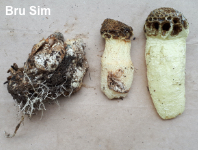| Major Groups > Stinkhorns > Lysurus periphragmoides |

|
Lysurus periphragmoides [ Basidiomycota > Phallales > Lysuraceae > Lysurus . . . ] by Michael Kuo Although the name "Lysurus periphragmoides" has usually been applied to a very different mushroom (see Lysurus species 01), recent research by Hernández Caffot and collaborators (2018) makes it clear that the true Lysurus periphragmoides, featured here, is a stinkhorn with a proportionally wide, whitish to yellowish stem that holds aloft a tightly latticed head structure that features many polygonal openings that get filled with brown spore slime. A recently described Indian species, Lysurus habungianus (Gogoi & Parkash 2015), is similar but features a head with numerous spike-like projections, a stem with a pimply (rather than ridged) surface, and larger spores. Other Indian species also appear to be similar, based on descriptions and line drawings in Acharya and collaborators (2010), but it is uncertain whether these are Lysurus periphragmoides or not. Thanks to Bru Sim for collecting, documenting, and preserving Lysurus periphragmoides for study; the collection is deposited in The Herbarium of Michael Kuo. Description: Ecology: Saprobic; growing alone or gregariously, usually in urban habitats (lawns, landscaping, gardens, compost heaps, and so on), but also in woods; distribution uncertain because of confusion with Lysurus species 01; originally described from Mauritus; also known from Asia; summer, or, in warm climates, year round. The illustrated and described collection is from the Philippines. Fruiting Body: Initially a brown "egg" up to about 3 cm wide and 4 cm high; emerging to form a mushroom with a stem and a head. Stem 4–7 cm long; 2–4 cm thick; whitish, becoming yellowish to orangish with old age; hollow; round in cross-section; more or less equal; with shallow veins and ridges; vaguely longitudinally grooved; spongy and soft; base encased in a brown to white volva that is attached to copious white rhizoids. Head consisting of a widely cushion-shaped to roundish lattice structure 2–4 cm across, formed by interconnected branches that surround small, polygonal openings; branches whitish to yellowish, with inner surfaces covered with malodorous, dark brown spore slime. Microscopic Features: Spores 3–5 x 1.5–2.5 µm; ellipsoid to subcylindric; smooth; hyaline in KOH. Context sphaerocysts 28–42 µm; subglobose to irregular; walls 0.5–1 µm thick; smooth; hyaline in KOH. Volval tissue composed of hyphae 2–4 µm wide, frequently septate, clamped at septa, smooth, thin-walled, hyaline to yellowish in KOH. REFERENCES: Klotzsch, 1831. (Acharya et al., 2010; Hernández Caffot et al., 2018.) Herb. Kuo 11141901.
This site contains no information about the edibility or toxicity of mushrooms. |
© MushroomExpert.Com |
|
Cite this page as: Kuo, M. (2019, December). Lysurus periphragmoides. Retrieved from the MushroomExpert.Com Web site: http://www.mushroomexpert.com/lysurus_periphragmoides.html |





